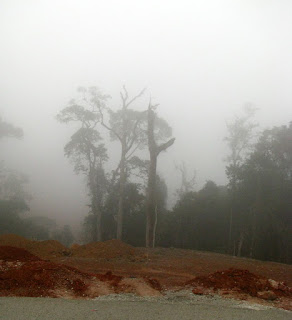The 200km drive from Dolasie to Pointe Noire (Congo) was one of the highlights of our trip -- a day of driving over a massive mountain range covered in ancient forests hidden under the clouds - on a new road being built by the Chinese.
All the vehicles and machinery -- and there is no shortage of anything -- have been brought from China, but the labour is local - and painfully young. These youngsters work for less than 2 Euros for a 14 hour day. The Chinese workers are apparently all convicts, recognisable by their tattoos. Nevertheless only they are in supervisory positions and seldom seem to do more than stand and oversee.
Scaling the man-made cliffs where the road has literally been cut through the mountain, the engineering skills are somewhat novel and unusual -- but
probably made possible by the abundance of cheap labour/manpower
Perhaps we were incredibly fortunate seeing the new road when we did: There was still the stunning landscape hidden until now under the clouds, untouched, unspoilt, undiscovered, and then, the cruel red gash through the mountain, through the forests, like a deep jagged knife wound. But also, we have to admit, the amazing engineering feat of this new road - which cannot fail to impress -- even if grudgingly...
There are moments when you could well look up and ask: When did we arrive in China?
The new road cut a swathe through the ancient forests, where the trees stand so tall it is difficult to give a perspective of their immense height.
Where the Chinese find minerals, gold, diamonds -- anything that can be mined and sent back to China, they do so, apparently without any stumbling blocks. Here, next to a Chinese mine (can someone tell me what it is?) the villages are covered in white dust -- giving an impression of snow in the tropics
A giant stand sentinel on the hill, looking at the devastation of what remains of a primeval forest around him. Interesting architecture as far as churches go...
The lush verdant green rain forest from the rainy season turns into a strange powdery red world where all the tropical plants are covered from head to toe in the finest talcum dust churned up by the logger trucks that speed up and down the dirt tracks
Mila-Mila where we stopped for cook group shopping (it was the only town that day where we could get something for dinner that night) was a very strange town... Dodge City springs to mind -- or better still, Dodgy City. At a cross roads - or rather where two dirt tracks come together into the single one, the logger truck drivers -- from Malaysia, Fillippines, Korea -- stop for a breather, to repair burst tyres and broken axles, to eat greasy chicken and drink beer and to visit the prostitutes who line up in their large numbers in festive aray, loud chatter and much joyful laughter.
On the plateau the rain forest turns to rolling hills and tall elephant grass - soft and dreamy. We cross many rivers on our journey -- often two or three a day, each one wide and deep and impressive -- so large that you would expect to have heard of the name somewhere in a geography lesson or a documentary on the great rivers of the world, but, here in Africa, just another river, like so many others...
Such vast areas where there is no habitation, no agriculture, just endless savannah, hills, far-off forests, rolling hills. And then, a welcome stream that beckons the traveller to come cool down and wash off all that dust before continuing...
A lone canoe glides down the river, bringing home a rich catch of plentiful fish.
A large flock of birds swoops across the cloudy sky, this way, then that - for the sheer pleasure of being alive!
Perhaps the beauty around us, perhaps a moment of missing being home, but whatever the inspiration for the little flower on the breakfast papaya, the gesture brought the gift of a smile; thank you Suzanne!

Suddenly, the women here in the Congo do not carry their heavy loads on their heads anymore, but rather in baskets slung from their heads. The baskets themselves are beautifully woven and works of art in their own right.
































No comments:
Post a Comment